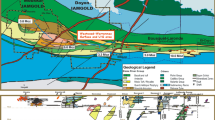Abstract
Extraction of a large volume of ore during block caving can lead to the formation of significant surface subsidence. Current knowledge of the mechanisms that control subsidence development is limited as are our subsidence prediction capabilities. Mining experience suggests that, among other contributing factors, geological structures play a particularly important role in subsidence development. A conceptual modeling study has been undertaken to evaluate the significance of geological structure on surface subsidence. A hybrid finite/discrete element technique incorporating a coupled elasto-plastic fracture mechanics constitutive criterion is adopted; this allows physically realistic modeling of block caving through simulation of the transition from a continuum to a discontinuum. Numerical experiments presented emphasize the importance of joint orientation and fault location on mechanisms of subsidence development and the governing role of geological structure in defining the degree of surface subsidence asymmetry.

























Similar content being viewed by others
References
Abel JF, Lee TF (1980) Subsidence potential in shale and crystalline rocks. U.S. Geological Survey Open File Report 80–1072, pp 49
Barton N, Lien R, Lunde J (1974) Engineering classification of rock masses for design of tunnel support. Rock Mech 6(4):189–236
Bieniawski ZT (1989) Engineering rock mass classifications. Wiley, London, p 272
Crane WR (1929) Subsidence and ground movement in the copper and iron mines of the Upper Peninsula, Michigan. USBM Bull 285:66
Elmo D, Stead D (2009) An integrated numerical modeling—discrete fracture network approach applied to the characterisation of rock mass strength of naturally fractured pillars. Rock Mech Rock Eng. doi:10.1007/s00603-009-0027-3
Elmo D, Vyazmensky A, Stead D, Rance JR (2008) A hybrid FEM/DEM approach to model the interaction between open pit and underground block caving mining. In: Proceedings of 1st Canada–U.S. rock mechanics symposium, vol 2, pp 1287–1294
Flores G, Karzulovic A (2002) Geotechnical guidelines for a transition from open pit to underground mining. Benchmarking Report for ICSII. Task 4. p 91
Golder Associates (2007) FracMan Technology Group. Home page at: http://www.fracman.golder.com
Hoek ET, Kaiser PK, Bawden WF (1995) Support of underground excavations in hard rock. A.A. Balkena, Rotterdam. p 300
Laubscher DH (1990) A geomechanics classification system for the rating of rock mass in mine design. J S Afr Inst Min Metall 90(1):257–293
Mahtab MA, Bolstad DD, Kendorski FS (1973) Analysis of the geometry of fractures in San Manuel copper mine, Arizona. Bureau of Mines. Technical report RI 7715
Munjiza A (2004) The combined finite-discrete element method. Wiley, Chichester, p 348
Munjiza A, Owen DRJ, Bicanic N (1995) A combined finite/discrete element method in transient dynamics of fracturing solids. Int J Eng Comput 12(2):145–174
Panek LA (1984) Subsidence in undercut—cave operations, subsidence resulting from limited extraction of two neighboring cave operations. In: Pariseau WG (ed) Geomechanical applications in hard rock mining, pp 225–240
Pine RJ, Coggan JS, Flynn ZN, Elmo D (2006) The development of a new numerical modelling approach for naturally fractured rock masses. Rock Mech Rock Eng 39(5):395–419
Pine RJ, Owen DRJ, Coggan JS, Rance JM (2007) A new discrete modelling approach for rock masses. Geotechnique 57(9):757–766
Rance JM, van As A, Owen DRJ, Feng YT, Pine RJ (2007) Computational modelling of multiple fragmentation in rock masses with application to block caving. In: Proceedings of 1st Canada–U.S. Rock Mechanics Symposium, Vancouver, vol 1, pp 477–484
Rockfield Software Ltd (2007) ELFEN user manual, Swansea, UK. Home page at: http://www.rockfield.co.uk
Rockfield Software Ltd (2009) Primary fragmentation at Northparkes E26 Lift 2 block cave. Technical report PRF1884, p 271
Sandvik Group (2004) Block caving animation
Stacey TR, Swart AH (2001) Practical rock engineering practice for practice for shallow and opencast mines. SIMRAC The safety of mines research advisory committee, p 66
Stead D, Coggan JS, Elmo D, Yan M (2007) Modelling brittle fracture in rock slopes: experience gained and lessons learned. In: Proceedings international symposium on rock slope stability in open pit mining and civil engineering. Perth, pp 239–252
Van As A, Davison J, Moss A (2003) Subsidence definitions for block caving mines. Technical report, p 59
Vyazmensky A (2008) Numerical modelling of surface subsidence associated with block cave mining using a finite element/discrete element approach. PhD thesis. Simon Fraser University, Canada
Vyazmensky A, Elmo D, Stead D, Rance JR (2007) Combined finite-discrete element modelling of surface subsidence associated with block caving mining. In: Proceedings of 1st Canada–U.S. Rock Mechanics Symposium, Vancouver, vol 1, pp 467–475
Vyazmensky A, Stead D, Elmo D, Moss A (2009) Numerical analysis of block caving-induced instability in large open pit slopes: a finite element/discrete element approach. Rock Mechanics and Rock Engineering. doi:10.1007/s00603-009-0035-3
Wilson ED (1958) Geologic factors related to block caving at San Manuel Copper Mine, Pinal County, Arizona. Progress Report, April 1956–1958. Bureau of Mines Rept. of Inv. 5336, p 40
Acknowledgments
The authors would like to acknowledge research funding provided by Rio Tinto and Natural Sciences and Engineering Research Council of Canada. We would also like to acknowledge research collaboration with Allan Moss and Andre van As (Rio Tinto), Erik Eberhardt, Scott Dunbar and Malcolm Scoble (University of British Columbia). Technical support of Rockfield Technology Ltd. (UK) is gratefully appreciated.
Author information
Authors and Affiliations
Corresponding author
Rights and permissions
About this article
Cite this article
Vyazmensky, A., Elmo, D. & Stead, D. Role of Rock Mass Fabric and Faulting in the Development of Block Caving Induced Surface Subsidence. Rock Mech Rock Eng 43, 533–556 (2010). https://doi.org/10.1007/s00603-009-0069-6
Received:
Accepted:
Published:
Issue Date:
DOI: https://doi.org/10.1007/s00603-009-0069-6




